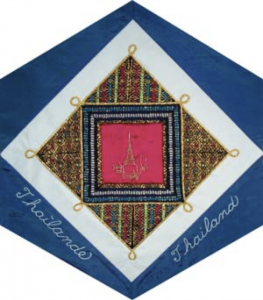Thailand

The Block
Suree Murphy’s reminiscences and ideas about her native Thailand inspired the design of this block. It features an outline of the country’s Grand Palace––where dazzling celebrations of holidays and major events are held throughout the year––immortalized in gold-couched thread. Thailand is famous for its ornate costumes embroidered with silver and gold, its spectacular art and architecture, locally mined gems and precious stones and, reflecting its distinct national identity, exquisite hand-woven fabric. This illustrious bounty is elegantly mirrored in the block’s shimmering multi-coloured silk background.
Cultural Profile
Thailand is located in Southeast Asia, bordered by Cambodia, Laos and Myanmar. It is a country of breathtaking scenery and its unique contour is often compared to an elephant’s head, with the “trunk” extending south into the narrow Malay Peninsula. This unusual shape means that the nation is more than twice as long from north to south (about 1,770 km) as it is wide from east to west (about 800 km). The Kingdom was known as Siam until 1939, and again for a few years during the late 1940s. In 1949, it adopted its current name for the second time. Thailand is the only Southeast Asian country never to have been occupied by any European or other foreign power, with exceptions during times of war. This distinction that has led to its nickname Prathet Thai, meaning “Land of the Free.” Today the country is a constitutional realm under the rule of H.M. King Bhumibol Adulyadej, Rama IX, the world’s longest-serving monarch.
Around 75% of Thailand’s population is classified as Thai. However, the country has a complex ethnic composition. The culture and language of the Thai themselves differ considerably depending on the region. Other ethnic groups include Chinese, Malays and indigenous hill-people belonging to one of the six known groups, which include the Hmong and Karen, a group well-known to foreigners for their ‘giraffe women’ who put brass coils around their necks. The official language, which is spoken by about 40 percent of the inhabitants, is standard Thai (formerly known as Siamese) and Chinese is widely used as well.
Thai people value serenity and harmony above all else. Disagreements are handled with a smile, while the concept of sanuk, literally ‘having fun’, is very important in for Thais, and encourages people to be positive at all times. The tradition of nicknames, usually one-syllable words often given to children at a very early age and used throughout one’s life, is also a notable element of Thai culture. Thai cuisine is one its best-known cultural exports, blending sweet and fiery flavours with rice, the main food staple. There are 500 known varieties of rice in the country.
Although the Thai have always been an agricultural people, harvesting a variety of fish and shellfish from the sea and cultivating wet rice, they are now an increasingly urbanized people working in manufacturing. In the vibrant capital city of Bangkok, for example, the old blends with the new as traditional multi-coloured wat, or temples, stand alongside modern skyscrapers. Some art forms, such as painting, sometimes fuse Thai ideals of beauty and form with modern, Western-influenced concepts. However the fundamental characteristics of traditional Thai culture still prevail in many mediums.
Thailand is known for numerous things, including a longstanding tradition of myths and legends from which Thai literature evolved, temple mural paintings, glazed ceramics, ornamental woodcarving, metal and lacquer work, and mother-of-pearl inlay. They are also renowned for the ancient art of Muay Thai, or Thai boxing, the national sport that has endured for centuries. Muay Thai is a disciplined sport that requires not only practicing the movements, but studying the science and art of them as well.
Thai textiles are known for their brilliant colours and lush textures. For example, members of the hill tribes have preserved their traditional clothing, which dazzle visiting tourists. Thai silk, with its natural shades of gold, is used to weave various clothes and items, including the traditional pha nung wraparound skirt that is worn by many women. Ikat weaving is practised in the country. In this time-consuming process, silk threads are tied dyed following the desired pattern, then woven into place to create beautiful, fine fabrics.
People have been coming to Canada from Thailand since the 1950s, many seeking better opportunities and a fresh start for themselves and their families. Although there are just over 14,000 Thai here, according to the 2011 census, they have made significant contributions to Canadian society. Thai are involved in a variety of fields, including banking, medicine and computers .Many restauranteurs have carved out an important and popular niche in Canada’s food service and hospitality industry, as Thai cooking is considered one of the world’s great cuisines. Others have established a number of organizations, such as The Thai Community Association of British Columbia, The Friends of Thailand in Vancouver, and The Thai Association of Ontario, where the door is always open to anyone looking to experience the Thai culture.
Sponsor: The Helle Family
